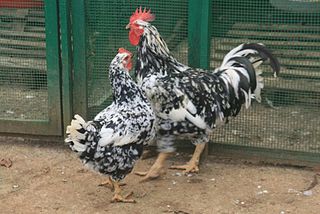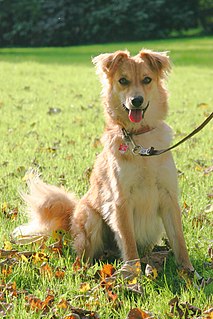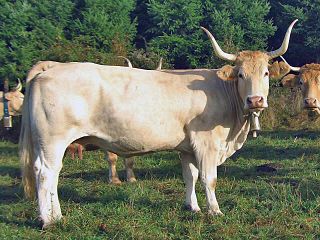Related Research Articles

The Pita Pinta Asturiana is the only breed of chicken indigenous to the principality of Asturias, in north-western Spain.

The Sayaguesa is an endangered Spanish breed of domestic cattle. It is named for the comarca of Sayago in the province of Zamora, in the western part of the autonomous community of Castile and León, and is raised almost exclusively in that area. It may also be known as the Zamorana, the Moles de Sayago or the Castellana variedad Sayaguesa. It was traditionally kept mainly for draught work, but is now raised principally for meat.

The Basque Shepherd Dog, Basque: Euskal Artzain Txakurra, Spanish: Perro de Pastor Vasco, is a traditional Spanish breed of sheepdog originating in the historic Basque Country. It is believed that they originated from Central European herding dogs.

The Mallorquín or Caballo Mallorquín is a rare breed of horse indigenous to the island of Mallorca in the Balearic Islands, from which it takes its name. Identification of the breed was begun in 1981 by the Patronato para las Razas Autóctonas de Mallorca. The Mallorquín is listed in the Catálogo Oficial de Razas de Ganado de España in the group of autochthonous breeds in danger of extinction.

There are a number of Basque breeds and cultivars. These are domesticated animals that have been bred - or plant species cultivated - for particular traits and features by Basque people in the Basque Country.

The Rubia Gallega, Galician: Rubia Galega, is a breed of cattle native to the autonomous community of Galicia in north-western Spain. It is raised mainly for meat. It is distributed throughout Galicia, with about 75% of the population concentrated in the province of Lugo. The coat may be red-blond, wheaten, or cinnamon-coloured.

The Burguete is a Spanish breed of horse from the autonomous community of Navarre in north-eastern Spain. It is listed in the Catálogo Oficial de Razas de Ganado de España in the group of autochthonous breeds in danger of extinction. It is reared principally for horsemeat.

The Betizu is a breed of small mountain cattle which live in a semi-feral state in some mountainous parts of the Basque Country in both Spain and France. It is classified as an endangered breed by both the Ministerio de Agricultura, Pesca y Alimentación, the agriculture ministry of Spain, and by the Conservatoire des Races d'Aquitaine in France.

The Zamorano-Leonés is a breed of large domestic donkey from the provinces of Zamora and León, in the autonomous community of Castilla y León, in north-western Spain. The name derives from those of the two provinces.

The Asno de las Encartaciones, Basque: Enkarterriko asto, is a breed of small domestic donkey from the western part of the autonomous community of the Basque Country, in north-east Spain. It is named for the comarca of Las Encartaciones (Enkarterri), in the province of Biscay (Bizkaia). It is the only small donkey breed of Spain, and resembles the Gascon donkey, now a sub-type of the Pyrenean donkey. The Asno de las Encartaciones is critically endangered, and is protected by conservation measures.

The Majorera is an endangered breed of small domestic donkey indigenous to the Canary Islands, the Spanish archipelago in the Atlantic off the coast of southern Morocco. There are approximately 200 of the donkeys; almost all are on the island of Fuerteventura, with a small number on Lanzarote. The name derives from majorero, a demonym for the people of Fuerteventura. The Majorera is a small donkey of African origin, and is the only equine breed of the archipelago.

The Euskal Oiloa, Spanish: Gallina Vasca, is a breed of domestic chicken from the autonomous community of the Basque Country in north-eastern Spain and south-western France. It is the traditional rural chicken of the area, a rustic dual-purpose breed of Atlantic type, and differs from Mediterranean Spanish breeds such as the Castellana Negra and the Minorca in several respects: it has yellow legs and feet, red earlobes, and lays brown eggs.
The Pasiega is a traditional Spanish breed of red dairy cattle from the autonomous community of Cantabria in northern Spain. It originated in the Valles Pasiegos in south-eastern Cantabria. The name derives from that of the Pas River, which flows through that region. Because of the colour of its coat it may also be known as the Roja Pasiega or Rojina.

The Terreña, Basque: Behi terreña, is an endangered breed of mountain cattle indigenous to the autonomous community of the Basque Country in northern Spain. It is distributed mostly in the provinces of Álava and Bizkaia, with some localised populations in Gipuzkoa.

The Palmera is an endangered breed of cattle from the island of San Miguel de La Palma, in the Spanish autonomous community of the Canary Islands. The cattle are not indigenous to the island, but were brought by European settlers in the fifteenth century. The Palmera derives from the Rubia Gallega breed of Galicia. It is distributed mostly in the municipalities of Breña Alta, Breña Baja, El Paso, Garafía, Los Llanos de Aridane and Villa de Mazo, with small numbers in the municipalities of Puntagorda, Santa Cruz de La Palma and Tijarafe; a few may be found on the islands of Fuerteventura and Tenerife.

The Menorquina is an endangered breed of cattle from the Mediterranean island of Menorca, in the Spanish autonomous community of the Balearic Islands. It belongs to the group of convex-profiled red cattle, whose distribution across the northern Mediterranean region is thought to have followed the path of the Bell-Beaker Culture. It is one of only two autochthonous Spanish breeds of dairy cattle, the other being the Pasiega. The milk is particularly suitable for cheese production, and is used to make Mahón cheese, which has DOP status.

The Pirenaica, Basque: Behi-gorri, is a breed of beef cattle indigenous to the Pyrenees of north-eastern Spain. It is distributed mainly in the autonomous communities of Navarre and the Basque Country, but is present in much of the northern part of the country. It is well adapted to the mountainous terrain and humid climate of the area. It came close to extinction in twentieth century, but is not now at risk.
The Villanuco de Las Encartaciones, Basque: Enkarterriko Billanuko, is a Spanish breed of small dog of ratter type. It originates in the comarca of Enkarterri in the Basque Autonomous Community in northern Spain. It is one of five Basque breeds of dog, the others being the Basque Shepherd Dog, the Erbi Txakur, the Pachón de Vitoria and the Villano de Las Encartaciones, and one of fourteen animal breeds native to the País Vasco.

The Monchina, Basque: Behi montxina, is a Spanish breed of mountain cattle indigenous to the autonomous communities of Cantabria and the Basque Country in northern Spain. It is related to the Betizu and possibly to the Terreña breeds of cattle of the Basque Country, and is closely associated with the Villano de las Encartaciones breed of dog, which is traditionally used in managing it. It is classified by the Ministerio de Agricultura, Pesca y Alimentación, the Spanish ministry of agriculture, as a "Raza Autóctona en Peligro de Extinción" or native breed at risk of extinction.

The Azpi Gorri is a traditional Spanish breed of domestic goat. It originates in the historical Basque Country, and is the only recognised goat breed of that area. It is distributed in the northern part of the province of Álava and in southern Bizkaia, with a few herds in the autonomous community of Navarre.
References
- ↑ Barbara Rischkowsky, Dafydd Pilling (editors) (2007). List of breeds documented in the Global Databank for Animal Genetic Resources, annex to The State of the World's Animal Genetic Resources for Food and Agriculture. Rome: Commission on Genetic Resources for Food and Agriculture, Food and Agriculture Organization of the United Nations. ISBN 9789251057629. Archived 23 June 2020.
- ↑ Breed data sheet: Euskal Antzara / Spain (Goose (domestic)). Domestic Animal Diversity Information System of the Food and Agriculture Organization of the United Nations. Accessed January 2021.
- 1 2 3 4 5 6 7 8 Miguel Fernández Rodríguez, Mariano Gómez Fernández, Juan Vicente Delgado Bermejo, Silvia Adán Belmonte, Miguel Jiménez Cabras (eds.) (2009). Guía de campo de las razas autóctonas españolas (in Spanish). Madrid: Ministerio de Medio Ambiente y Medio Rural y Marino. ISBN 9788449109461.
- 1 2 Raza aviar Euskal Antzara: Datos Morfológicos (in Spanish). Ministerio de Agricultura, Pesca y Alimentación. Accessed January 2021.
- ↑ Euskal Antzara (in Spanish). Berriz, Bizkaia: Euskal Abereak. Archived 26 November 2020.
- 1 2 Raza aviar Euskal Antzara: Datos Generales (in Spanish). Ministerio de Agricultura, Pesca y Alimentación. Accessed January 2021.
- ↑ Euskal Antzara: Avicultura (in Spanish). Federación Española de Asociaciones de Ganado Selecto. Accessed January 2021.
- ↑ Juan José Ibarretxe Markuartu (26 December 2001). N°-429: Decreto 373/2001, de 26 de diciembre, sobre razas animales autóctonas vascas y entidades dedicadas a su fomento (in Basque and Spanish). Euskal Herriko Agintaritzaren Aldizkaria/Boletín Oficial del País Vasco14: 1080–1087.
- ↑ Espinosa Mangana (3 March 2006). Orden APA/661/2006, de 3 de marzo, por la que se sustituye el Anexo del Real Decreto 1682/1997, de 7 de noviembre, por el que se actualiza el Catálogo Oficial de Razas de Ganado de España (in Spanish). Boletín Oficial del Estado59 (10 March 2006): 9656–9657. Reference: BOE-A-2006-4302. European Legislation Identifier: permalink.
- 1 2 Oca Basca: Euskal Antzara: Arca del Gusto (in Italian). Bra, Cuneo: Fondazione Slow Food per la Biodiversità Onlus/Slow Food Foundation for Biodiversity. Archived 26 January 2021.
- ↑ Raza aviar Euskal Antzara: Usos y sistema de explotación (in Spanish). Ministerio de Agricultura, Pesca y Alimentación. Accessed January 2021.
- ↑ Raza aviar Euskal Antzara: Datos Productivos (in Spanish). Ministerio de Agricultura, Pesca y Alimentación. Accessed January 2021.